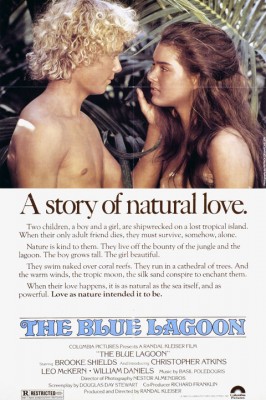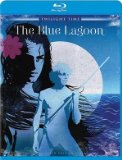| Reviews & Columns |
|
Reviews DVD TV on DVD Blu-ray 4K UHD International DVDs In Theaters Reviews by Studio Video Games Features Collector Series DVDs Easter Egg Database Interviews DVD Talk Radio Feature Articles Columns Anime Talk DVD Savant Horror DVDs The M.O.D. Squad Art House HD Talk Silent DVD
|
DVD Talk Forum |
|
|
| Resources |
|
DVD Price Search Customer Service #'s RCE Info Links |
|
Columns
|
|
|
Blue Lagoon, The
A Twilight Time release licensed from Columbia Pictures/Sony, the Blu-ray of The Blue Lagoon is pretty much flawless, with the outstanding video transfer and 5.1 DTS-HD Master Audio mix keeping it interesting. Previously released extras also add much to the overall package.
Adapted from Henry De Vere Stacpoole's 1908 romantic novel (and set in that period), the film opens with young motherless boy Richard Lestrange (Glenn Kohan) traveling by ship with his father, Arthur (William Daniels), and his orphaned ward, Emmeline (Elva Josephson). The ship catches fire, and though Richard and Emmeline, with the help of crusty ship's cook, Paddy Button (Leo McKern), make it safely to a lifeboat, a think fog separates them from the other survivors.
The three eventually reach land: an uninhabited island with abundant fresh water and fruit. Paddy teaches the children basic survival skills, and after he discovers the remains of human sacrifices on the far side of the island, lays down "the law," prohibiting them from visiting there. However, not long after they're marooned Paddy dies and the children now must survive with no adult supervision at all.
Several years later, Richard (now played by Christopher Atkins) and Emmeline (Brooke Shields) are teenagers and, somewhat unbelievably, none the worse for wear. Indeed, they enjoy an ideal, off-the-grid existence and seem quite content. But then Emmeline experiences (and is caught unawares by) her first menstrual cycle while Richard begins looking at her in a whole new light.
The Blue Lagoon was heavily promoted as something approaching an art film, "a story of natural love" emphasized in the movie's trailers and on the posters. Audiences, namely teenagers who snuck in to see this R-Rated movie, didn't buy this, and went mainly for the titillation of watching Atkins and Shields getting hot 'n' heavy in the nude while learning about sex. For them, The Blue Lagoon was more like an artful Porky's.
It was a personal project for its producer-director, Randal Kleiser, then just 33 years old, riding high on the huge success of Grease (1978), and therefore pretty much in a position to realize his chancy film. I didn't see The Blue Lagoon when it was new nor have I read the novel, but about a third of way into the movie I had an unexpected epiphany: I suddenly realized I was watching a movie about heterosexual love channeled through a gay filmmaker's vision. I didn't know whether Kleiser was gay or not, but after pausing the film and checking the Internet I discovered that, yes, in fact, he is, and quite open about it.
Back in 1980, 14-year-old Brooke Shields garnered most of the attention. A lifelong model, she had already invited controversy after appearing as a child prostitute in Louis Malle's Pretty Baby (1978) while her character here is frequently nude in The Blue Lagoon, though Shields herself is obviously doubled throughout.
Generally however, Shields's Emmeline is quite demure, with Shields's long brown mane discreetly covering (and reportedly taped to) her breasts. Fairly flat chested at that time, with famously full eyebrows, Shields is almost boyish. But (also gay) Néstor Almendros's camera lingers longingly on the frequently full-frontally nude Atkins, with Emmeline fascinated by his muscles. Richard would appear to be a gay man's fantasy of the unspoiled, athletic, tanned blonde virgin, much more than Shields projects the beautiful, virginal girl for heterosexual men.
Indeed, their early scenes together almost suggest a love affair between a masculine boy and a mildly feminine one, and by the end the film Kleiser and Almendros seem less interested in their study of frank heterosexuality than in equating the island's physical beauty with the beauty of the human body, particularly Atkins's. Once Emmeline becomes pregnant, Kleiser's growing disinterest in her character is fairly obvious. During childbirth, for instance, Shields's character doesn't even sweat nor is there any blood, umbilical cord, or afterbirth, with Emmeline miraculously delivering a perfect, pre-cleaned infant with skin as white as snow. (Reader Sergei Hasenecz points out this is in keeping with its early 20th century fantasy literature roots, adding, "I mean, the kids don't even get sunburned.")
In one sense, Kleiser's to be applauded for getting such a frank, uninhibited film made at all - How did they cut this for network television? - and by a Hollywood major, no less. In this prudish age when parents' innocent pictures of their two-year-olds frolicking in a bubble bath warrants a call to the cops courtesy the photo department at Wal-Mart, it's not inconceivable that a movie as explicit as The Blue Lagoon would be labeled child pornography.
The picture has its share of interesting ideas. In one scene, as Richard watches Emmeline swimming in the blue lagoon, Kleiser and Almendros employ a visually interesting trick developed by Kleiser's brother Jeffrey, which illuminates the lagoon as if it were electrically charged.
Video & Audio
No complaints here. Presented in its original 1.85:1 aspect ratio, the 1080p presentation is essentially flawless. The image is perfectly sharp, with outstanding color, contrast, and clarity even (or maybe especially) in the gorgeous underwater scenes. The 5.1 DTS-HD Master Audio is equally impressive, with Poledouris's score and ambient jungle noises effectively channeled to the surround speakers. Optional English SDH are available, and as with most other Sony-controlled titles the disc is region-free.
Extra Features
Previously available supplements have been ported over. They include two audio commentary tracks, one with Kleiser, Shields, and screenwriter Douglas Day Stewart, the second with Kleiser and Atkins; a featurette from 1980, An Adventure in Filmmaking: The Making of 'The Blue Lagoon'; several teasers and trailers, all in high-def.
New to Blu-ray are an isolated score track and the usual well-researched Twilight Time booklet essay by Julie Kirgo.
Parting Thoughts
Not good but not entirely terrible, The Blue Lagoon nonetheless fascinates, but not perhaps for the reasons its filmmakers intended. Twilight Time's limited edition (3,000 units) Blu-ray is superb, however, and if nothing else it's a beautiful film to watch and listen to. Highly Recommended.
Stuart Galbraith IV is a Kyoto-based film historian whose work includes film history books, DVD and Blu-ray audio commentaries and special features. Visit Stuart's Cine Blogarama here.
|
| Popular Reviews |
| Sponsored Links |
|
|
| Sponsored Links |
|
|
| Release List | Reviews | Shop | Newsletter | Forum | DVD Giveaways | Blu-Ray | Advertise |
|
Copyright 2024 DVDTalk.com All Rights Reserved. Legal Info, Privacy Policy, Terms of Use,
Manage Preferences,
Your Privacy Choices | |||||||















